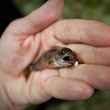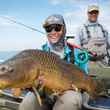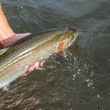Winter is a great time to go fly fishing. While far too many anglers are busy at the vice instead of on the water, trout keep doing what they do, albeit a bit more slowly and methodically. And so there are trout to be caught and far fewer anglers to compete with. But winter fly fishing comes with its own set of difficulties and frustrations, chief amongst them those that come when temperatures drop below the freezing mark. Freezing temperatures bring ice, which wreaks havoc on fly rods, lines and reels. Colder temperatures also make an angler's exposed hands and fingers not only unpleasant but potentially dangerous.
If only there was a way to go fly fishing in winter while avoiding all of these common aggravations. Well, perhaps there is: tenkara. By nature, tenkara fishing can offer a respite from many of the complications that a traditional fly rig faces when hitting an icy stream.
No Guides
The first casualty in a fly angler's arsenal in frigid winter temperatures is the guides on their fly rod. As the wet fly line slides through the guides, water is transferred to the guides and in minutes they begin to develop an icy crust. Before long, they're caked. Lines stick, casting goes to pot, leaving the angler to repeatedly clean and treat the guide to prevent icing.
Because Tenkara rods use a fixed, level line attached to the tip of the rod, they have no guides for ice to collect on.
No Reel
Frozen reels can be a bane to winter fisherman in search of sizable quarry like steelhead, where a functioning reel is required in order to land a fish. The same can be true for the trout fisherman, but most often frozen reels are a nuisance when trying to perform basic line management like stripping off more line for a longer cast, or even spooling up line simply to move downriver.
In tenkara fishing, there are no reels.
Warm Hands
Stripping a wet fly line quickly leads to wet, cold hands. Cold hands are unpleasant, potentially dangerous (think frostbite) and almost always mean shorter days on the water.
Trying to handle a fly line with gloves, even a good pair of fishing gloves, isn't often a recipe for success. Handling fly lines with your hands in your pockets is even more difficult. Unfortunately, those are the only two ways of keeping your hands warm when fly fishing in winter.
Tenkara rods only require one hand for casting and retrieving a fly. You don’t strip line with a tenkara rod, you just raise the trip to retrieve the fly. Because there's no line to strip, gloved hands aren't an impediment, leaving anglers free to wear even bulky, heavily insulated gloves. If you still prefer to go gloveless, most people quickly learn to cast and fish with either hand so if one hand gets cold just switch hands and stash the other one in your pocket to warm it up.































Comments
Steve replied on Permalink
Great article...Living here in Idaho Falls, I've already experienced frozen reels and guides this season. I was just telling my wife the other day that it's time to breakout the Tenkaras for all the reasons mentioned above...well time article, thanks!
Larry replied on Permalink
I agree with tenkara as a great winter tackle strategy but there are 2 icing up problems you may encounter. First is that a damp rod will freeze solid and not allow extension. Warm the rod inside your coat until it thaws. An extended rod may freeze at the joints too and lot allow retraction. Use your hand warmth at the joints to melt the ice and allow retraction. Ice may also form on the line and rod tip as you fish. Swishing it underwater for 15 seconds often melts it off. Be careful if you try to chip it off with your fingernails as the tip is brittle and easily broken. I also like to carry an electric hand warmer, which doubles as a phone charger.
Charles replied on Permalink
Another plus in my book is that tenkara rods are very good for tight-line nymphing. And tight-line nymphing is a good way to fish in the winter.
Pages